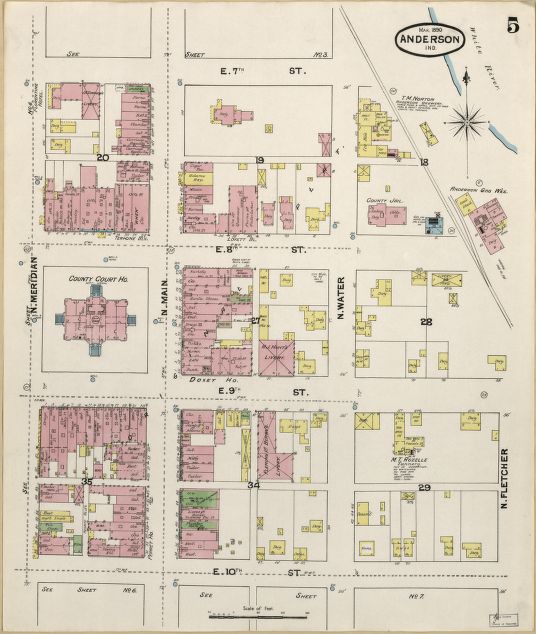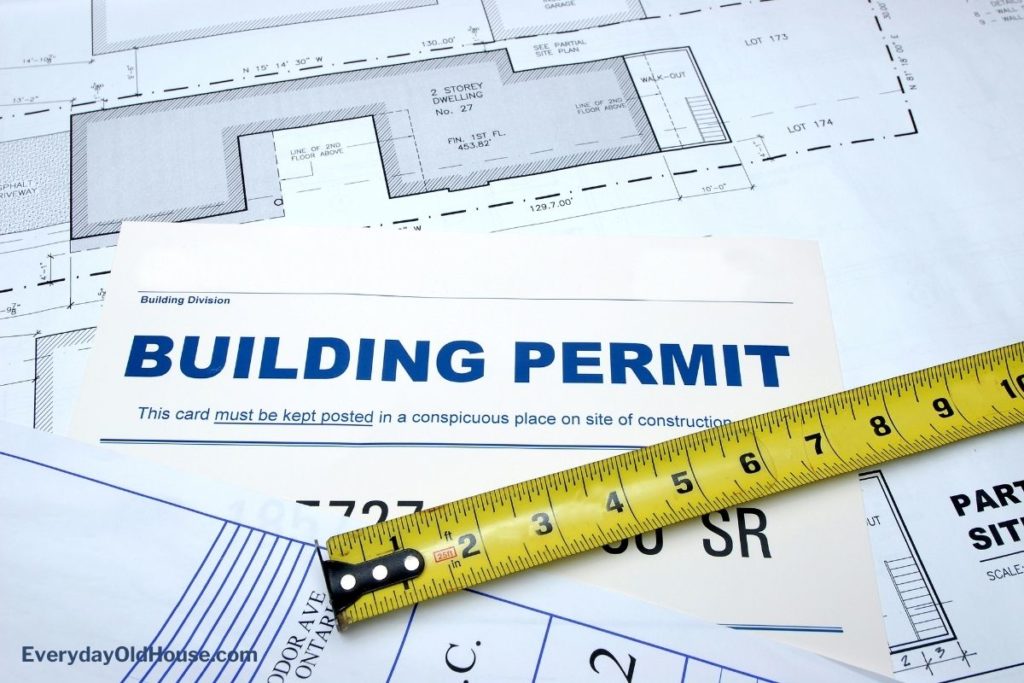How old is your house? Seems like a basic question, yet it’s one that many homeowners can’t answer. Interested in pinpointing how old you house is and learning more about its history? Without further ado, here’s 13 free ways to determine your home’s construction date.

Why is Your Home’s Construction Date Important?
There are a several reasons why you should determine your home’s construction date. Perhaps you own an older house and are interested in applying for a historic registery. Or looking to sell your home and gathering information to maximize its value and selling price.
More importantly (in my mind), a home’s construction date aids in creating your home’s maintenance plan. How? If you know your home’s construction date, you have a starting point to understanding the age of home’s components (i.e. plumbing, electric) as well as appliances. With this information, you can plan and budget preventative maintenance and replacement, which results in less costly surprises.
13 Free Ways to Determine Your Home’s Construction Date
Let’s dive into the 13 ways to determine your home’s construction date. Note that the first few ways (i.e. tax records, deeds, building permits, etc.) are written records and commonly the most accurate. You should try to find these first.
But sometimes those records are not available. Or they list your home’s construction date, BUT contradict each other and the years don’t match! Yikes!
If that occurs, check out the remaining ways further down the list, such as maps, old photos, or neighbors. These ways won’t necessarily pinpoint a specific construction year. But they can narrow it down to a range of years with a reasonable degree of certainty.
Wishing you the best of luck!
1. Tax Records
Taxpayers in every state (plus the District of Columbia) pay property taxes on their homes, a tax levied on “real property” (i.e., land and buildings). Tax records (commonly found at the local government level) are commonly updated every year and list the property owner and assessed value. Some tax records specifically record a home’s construction date.
However, if the construction date is not noted, there is still a way to ascertain when your home was built. Notice how the assessed value changes from year to year. As you probably see from your tax bill every year, your assessed value tends to change slightly every year.
However, do you spot a sudden jump in valuation for a particular year? Then it safe to assume a substantial renovation or even construction of a new home. That may be the construction date (or major removation date) of your home.
2. Deeds
When you purchased your home, you likely also received a copy of the deed. This is the legal written document that records property transfers or sales. Every transaction of property stays on file with the county’s Registry or Recorder of Deeds.
If you own an older house, it’s likely passed through several hands over the years. Luckily, there should be a corresponding deed for each transaction with the Registry. If you gather up all the deeds for a property and connect them in chronological order, you create a “chain” of ownership, or “chain-of-title”.
And this “chain-of-title” contains powerful information. While deeds describe the sold property through surveyed coordinates, deed commonly also document structures (commonly referred to as “improvements”). Therefore, your deed may mention a house, garage, barn, or even outhouse(!) that can help decipher your home’s construction date.

3. Title Insurance
Commonly as part of the mortgage process in buying a home, homeowners may purchase a title insurance policy, whether it be a lender or owner policy.
As part of the evaluation, the insurance underwriter is required to create a chain of ownership from deeds associated with the property. And your home’s construction date may be disclosed in the title insurance.
4. Home Appraisal
A common part of the home buying process (especially if you have a mortgage) is the home appraisal. Simply, it is an unbiased professional opinion of a home’s value using in-person inspection of the home’s components (i.e. square footage, amenities), price comparison of similar properties and current market trends to estimate the worth of a home.
As part of the appraisal process, the home appraiser may have taken note of your home’s construction date and recordrd it in your home appriasal.
5. Architecture and Design
By looking at your home’s architecture and design, you may be able to narrow down to a range of construction years. (Of course, this is easier to do if you house hasn’t been recently renovated.)
If you don’t know where to start, check out your local library for architectural guides for comparison. My personal fav resource? A Field Guide to American Houses by Virginia McAlester or the Brent Hull YouTube Series on American Architecture.
By looking at the exterior and interior features of your home, these guides will show you how to evaluate your home and determine which architectural style is likely fits into – Colonial, Victorian, Craftsman, or mid-century Modern. For example the style of our home (American Foursquare) places the construction date in the very late 1800s to early 1900s.
And you’ll also evaluate the materials used to construct the house to narrow down a range of construction dates. For example, does the home still have those pesky 9” x 9” asbestos kitchen tiles? If so, then your home was either constructed (or renovated) between 1920-1960s.
6. Fixtures
Does your bathroom have the original fixtures? If so, many fixtures, especially the toilet, may have a manufacturing date stamped somewhere on it.
Personally I didn’t know that fixtures had stamped manufacturing dates until we decided to remove the random toilet in our basement. As further detailed here, the toilet had a stamped manufacturing date, but it was about 15 years after the home’s construction. So while it’s not a full-proof method to determine your home’s construction date, it can help give an idea.
7. Attic & Basement
Sometimes you don’t even need to leave your home to get the information you need. Unfinished attics or basements may contain clues that can narrow down your home’s construction date.
Concrete, brick, or even pipes in basements or support beams in attics may have been marked with a construction date. Newspapers with print dates used as insulation under attic floors or within wall cavities may give you an idea of your home’s construction date.
Although rare, if you discover repeated markings or stamps on unfinished lumber in your attic, you may own a kit house. If so, you’ll definitely want to reach out to experts in the field like Rachel Shoemaker, Rosemary Thorton and Andrew Mutch.
8. Maps
I love maps. They provide a compelling visual history of a neighborhood or town. As detailed further here in 5 Places to Find Old Maps of Your Town, there are a variety of historical maps that may help you determine the construction year of your home. Depending on where you live, you might be more apt to come across topography maps in rural areas, cadastral maps in the Mid-West and West, or Fire Insurance maps in urban areas.

The most promising resource to determine your home’s construction date are Fire Insurance maps. These hand-drawn maps were made by professional surveyors for the insurance industry to assess the risk of fire. The most prominent company, Sanborn, produced maps for almost 100 years (from 1866 until the 1960s). They produced over 1.2 million maps of approximately 12,000 American cities and towns.
9. Historical Commission and Society
Your town’s historical society and commission can be a treasure trove of information about your town. It was a key component and saved me a lot of legwork when I was interested in learning the history of my house.
Contact these amazing resources to see what they may have available for review. They may have old census records, maps, city directories, or other documents that can help you narrow down the construction date of your house.
10. Realtors
A competent realtor has the research skills and access to a variety of resources to compile relevant information on a house – such as square footage, architectural style, and construction date. Talking to a realtor is a great way to determine your home’s construction date.
If you don’t want to talk directly to a person, check out various online realty databases, such as Zillow, Redfin and Realtor.com. These databases pull available information from the same public records as a realtor, which includes a home’s construction date.
11. Building Permits
Most local governments maintain an office (building department, engineer’s office/ planning commission) that maintain files for every significant structure in town. These files contain permits associated with major changes or improvements to a property. And that includes a permit for new construction of a home.

Admittedly, the sophistication of the permit process wasn’t as good in the past. So the older the house, the less likely you will discover a detailed new construction permit. But worth a try.
If you run into a dead-end with permits, speak directly with an Inspector. They may be a long-time employee who can shed additional light on your home’s file.
12. Library
Most local libraries devote a section just to your town’s history. This area contains a wide range of resources such as aerial maps, newspapers, census records, surveys, building plans, even old photographs.
If you decide to research the history of your house, including its construction date, save yourself time and effort by reaching out to a librarian first to get advice on where to start. It’s doubtful that the library has its resources indexed by address, so this method of diving into the library’s archives may require time and effort.
13. Neighbors
Sometimes the information you want isn’t sitting in a dusty file. Stretch your legs and networking skills, reach out to your neighbors and get information about your house. Or perhaps they are still in touch with your home’s previous neighbors and willing to ask on your behalf.
Unfortunately, the older your house is, the less likely you will find an elderly neighbor who can pinpoint the construction date of your home. But you still may get clues about your house and neighborhood that can help narrow it down to a range of construction dates.
Next Step?
Interested in learning even more about the history of your old house? Perhaps who used to live there? Or these other 4 reasons to research the history of your house? If so, be sure to check out my free Beginner’s Guide to Researching the History of Your Home.
Disclaimer
I am not a professional home genealogist (nor play one on tv….). However, as a environmental consultant for 10+ years, I researched the history of 100+ commercial properties for property owners, potential buyers, and real estate developers. I utilized a variety of historical databases and resources – historical maps, government databases, interviews, and property visual clues – to create a picture of a property’s past.
My mission is to use these consulting skills (combined with genealogy classes) to help other homeowners to research the history of houses.
Note that my experience is limited to the United States. For European homes, I suggest this website.
Related Posts
Want to be the first to know about new posts? Be sure to follow me on Pinterest, Facebook, Instagram or Twitter of even Etsy! Or better yet… Subscribe below!
My monthly (admittedly sometimes more, sometimes less….) emails are like receiving a unexpected letter from an old friend WITHOUT needing to put on your slippers and walk out to your mailbox…. See? I got ya, my friend!)
[Note: My posts are proudly connected to these amazing link parties full of DIY ideas and inspiration!]




